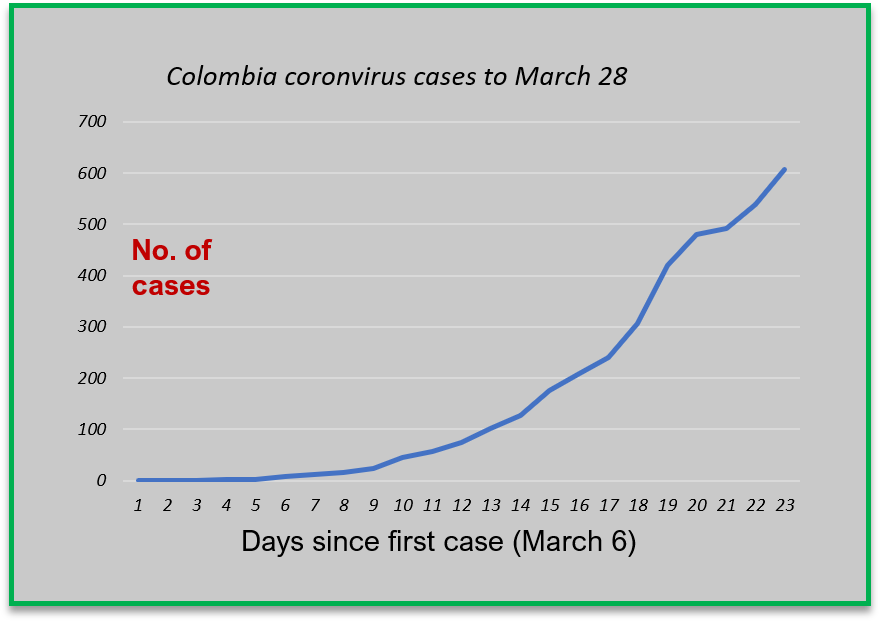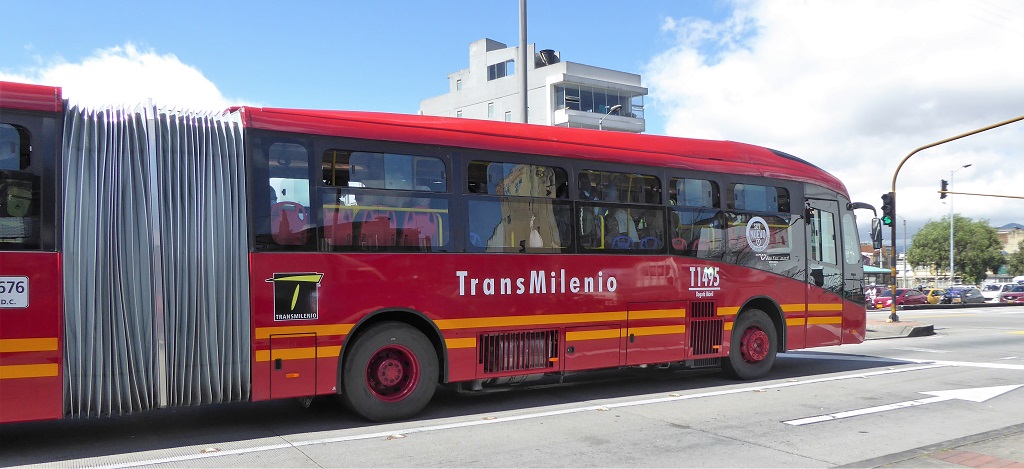
Key points on coronavirus cases in Colombia:
- 608 cases detected after three weeks of outbreak.
- No new deaths reported in two days. Total deaths stays at six.
- Bogotá showing biggest rise with hot-spots in Usaquén, Chapinero and Suba.
- Testing glitches could give misleading case numbers.
Latest data shows the rate of contagion is increasing in Colombia, despite faults in COVID-19 testing continuing to cast doubts over the true picture of coronavirus in the country.
Coronavirus: What were they thinking?
In the last update (March 26) we highlighted problems with quality of patient samples and geographic scope of tests. Then Colombia’s main health lab at the Instituto Nacional de Salud (INS) suffered key equipment failure, creating a backlog of unprocessed sample.
The machinery is now fixed but the glitch seems to have created a dip in positive cases last Friday – only 10 confirmed for COVID-19 according to INS data.

Bogotá, Colombia’s capital, continues as the main hot-spot with 264 cases to date, 43% of the total in country’s total – a percentage that has stayed fairly steady for a week now – and 50% of the deaths.
Globetrotting virus carriers
Roughly 80% of the Bogotá cases are directly connected to people who flew in from other countries, the majority from Spain and Italy showing the city’s vulnerability as a hub for international spread of the virus.
We could tentatively conclude that this travel factor explains the concentration of cases in the city’s wealthier barrios – Usaquén (38 cases), Chapinero (30), Suba (27) where globetrotters and their families are more likely to reside.
Read all our coronavirus coverage here
According to official data, poor barrios down south have hardly been affected so far. Highly populated Ciudad Bolívar and Usmé have only recorded one case each.
This is likely to change in coming weeks as the virus spreads by local community transmission, and air travel bans reduce imported cases.
We can welcome the fact there were no new deaths reported in the last two days, leaving the total at six cases.
Speed test
There is also small comfort that Colombia is not alone in its COVID-19 testing problems: Many countries including US, Italy and the UK have messed up this vital part of the response leaving health experts with a insufficient data to shape their response.
This partly explains the wildly varying death rates from the virus across then world, from 0.5% (Germany) to a horrifying 10% (Italy) since if we have limited lab testing we never know how many people were actually infected. Or how many really died of the disease.
New coranavirus detection devices and ‘rapid tests’ are being rushed out around the world, including a five-minute portable kit announced today.
Young and coronavirus-death free?
Will Colombia’s relatively young population mean less coronavirus deaths? Let’s hope so. Worldwide stats show a sharp increased in COVID-19 fatality rate over 70 years of age. See the table below from Worldometer.
| AGE | DEATH RATE WORLDWIDE (probability of dying if infected by the virus) |
| 80+ years old | 14.80% |
| 70-79 years old | 8.00% |
| 60-69 years old | 3.60% |
| 50-59 years old | 1.30% |
| 40-49 years old | 0.40% |
| 30-39 years old | 0.20% |
| 20-29 years old | 0.20% |
| 10-19 years old | 0.20% |
| 0-9 years old | 0 |
Colombia’s relatively young average age of 30 years could means less fatalities since younger people get a less severe illness.
In Colombia only 7.5% of the population is over 70 years old. Compare this to Italy, with an average age of 47 and 20% of the population is over 70, where you would expect at least twice as many deaths.
The scramble to make beds
Another key factor in reducing coronavirus deaths is a health system’s capacity to save lives, and the last days we have seen the US, and European countries, scrambling to set up emergency intensive care wards and source equipment such as ventilators which keep severe patients alive.
One shocking fact revealed by El Tiempo today was Colombia’s lack of ‘UCI’ (intensive care) beds, currently there are 5,000 across the country though five large departments (Vaupés, Vichada, Guainía, Amazonas y Guaviare) are without a single one. It has long been a tradition to transfer patients from these places in air-ambulances to Bogotá or Villavicencio.

Added to that, 80% of the current ICU beds in Colombia are already full with other patients. How will we cope?
According to projections reported by El Tiempo, even under the best case scenario, by May the country will need 16,000 ICU beds to cope with severe cases.
Coronavirus leaves tourists stranded in Colombia.
So like many other countries, Colombia is in a race against time to ready its health system and, as mentioned in previous updates, is creating pop-up hospitals in warehouses and conference centres.
But will it be enough? And will they have the hi-tech equipment to keep people alive? We’ll bring you updates in the coming days.





